Best General Ledger Software 2025: Reviews, Features & Pricing
.jpg)
General ledger software helps companies to record financial transactions, maintain compliance documentation, and generate accurate financial statements. ¹ The following analysis evaluates ten general ledger platforms across organizational scales–from small business to enterprise.
Evaluation criteria include automation capabilities; compliance support for standards like ASC 606 and SOX; scalability parameters; integration ecosystems, and pricing structures. The assessment includes vendor specifications, published pricing, and industry certifications from sources such as AICPA and Gartner.
The solutions are categorized by organizational fit based on company size, industry requirements, and technical complexity, rather than hierarchical ranking. Each platform addresses specific operational requirements for different business structures.
Quick Comparison table
HOW WE SELECTED THESE 10 GL SOLUTIONS
Selection methodology and evaluation criteria
Our selection criteria for general ledger software assessment covers multiple factors that impact a company’s accounting setup. The evaluation process examines automation capabilities and determines how extensively systems cut out manual data entry and process recurring transactions without manual involvement. Compliance support is another critical factor, encompassing built-in functionality for regulatory requirements.
The compliance features we assessed include:
- Revenue recognition automation aligned with ASC 606 ²
- Lease accounting standards per ASC 842 ³
- Sarbanes-Oxley internal control documentation ⁴
- Audit trail maintenance and reporting
- Financial statement preparation following GAAP standards ⁵
Scalability parameters assess each platform's capacity to grow with a business. Key considerations here include transaction volume limits, user capacity thresholds, multi-entity support, and system performance as data volumes increase. A solution appropriate for 25-employee companies may not support 250-employee operations without platform migration.
Integration ecosystems determine compatibility with accounts payable systems, payroll processors, and BI tools. The number of pre-built integrations impacts implementation complexity. Systems offering 200+ native integrations require less custom development compared to platforms with limited connector libraries.
Pricing transparency refers to published rate structures versus custom quotation requirements. Assessment here includes base subscription fees, per-user charges, implementation costs, and ongoing support expenses. Note: some vendors publish tiered pricing, but others require organizational assessment before cost disclosure.
Multi-entity management functionality allows organizations operating multiple legal entities to maintain separate books while generating consolidated statements. ⁸ This is necessary for parent companies with subsidiaries and private-equity portfolio structures.
Advanced reporting capabilities include customizable financial statements, dimensional reporting for department and project analysis, and data export functionality. Organizations need the ability to generate reports without extensive spreadsheet manipulation.
Other assessment factors include vendor stability and market presence. Established vendors with significant user bases provide more extensive documentation and third-party integration options compared to newer market entrants.
The evaluation incorporates vendor documentation, user- capacity specifications, and compliance certifications. Industry research from Gartner and AICPA endorsements inform the analysis. ¹² User-review platforms, including Capterra and G2, provide additional validation. ¹³ Solutions range from $15 monthly subscriptions for small business applications to enterprise platforms with custom pricing based on organizational complexity.
Comparative analysis: top 10 general ledger software solutions
1. DualEntry
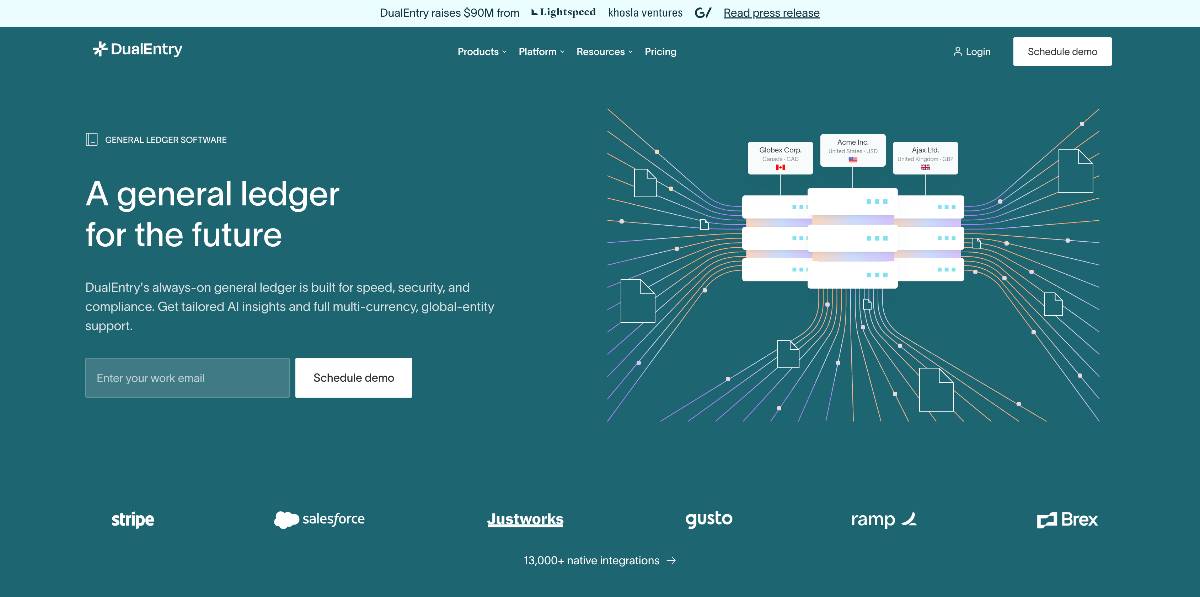
G2 rating: 4.9/5 (122)
DualEntry provides cloud AI-native general ledger functionality for mid-market organizations. The platform emphasizes automated transaction processing with AI-powered anomaly detection for duplicate payments and unusual transaction patterns.
Core capabilities:
- Unified ledger architecture flags duplicate vendor payments exceeding $5,000
- Multi-entity management supports 1-50+ legal entities from a centralized dashboard
- Pre-built integrations with 200+ applications, including Salesforce, Stripe, ADP, Bill.com
- Real-time audit-trail generation with automated bank reconciliation
- Implementation timeline averages 4-6 weeks
Organizational fit: Growing companies with 50-500 employees that need a scalable accounting infrastructure without extensive implementation timelines.
Advantages:
- Fast implementation reduces time-to-value, compared to legacy ERP systems
- Automation capabilities minimize manual transaction processing
- Multi-currency and consolidation functionalities support international operations
- Platform accommodates organizational growth without migration requirements
Limitations:
- Pricing available on request, based on organizational requirements
- Feature set exceeds requirements for organizations under 20 employees
- Users transitioning from entry-level accounting applications need platform training
Pricing structure: Custom pricing determined by entity count, user licenses, and transaction volume.
2. NetSuite
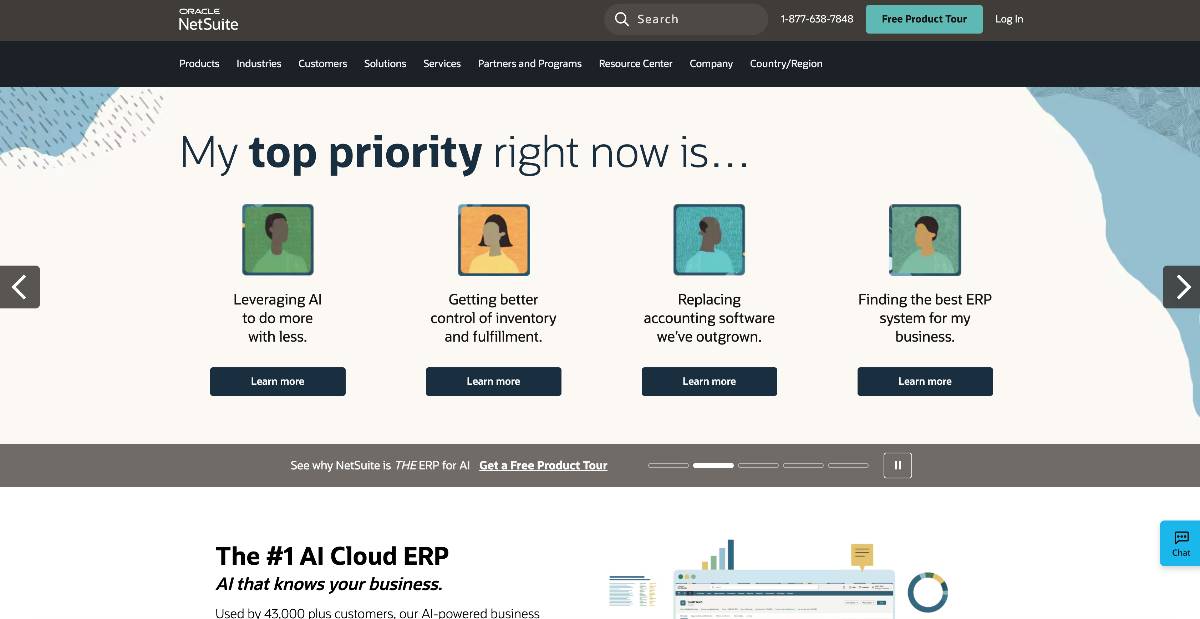
G2 rating: 4.1/5 (4,354)
NetSuite is Oracle's cloud-based Enterprise Resource Planning solution, featuring a comprehensive general ledger functionality. The platform provides global consolidation capabilities and extensive customization for complex organizational structures.
Core capabilities:
- Multi-company consolidation with automated intercompany elimination entries
- Customizable chart of accounts with approval workflow configuration
- Real-time dashboard reporting with financial analytics
- Revenue recognition automation compliant with ASC 606
- Integrated ERP modules, including inventory management, order processing, and CRM
Organizational fit: Enterprise organizations exceeding $10- million annual revenue with multi-entity structures and complex accounting requirements.
Advantages:
- Enterprise-grade scalability supports large organizational structures
- Comprehensive functionality eliminates the need for separate financial applications
- Global capabilities handle international accounting requirements
- Unified platform integrates business operations in a single system
Limitations:
- Implementation costs range from $50,000-$150,000 for 50-user deployments
- Configuration complexity requires specialized implementation resources
- Total cost of ownership exceeds small- and mid-market organizational budgets
Pricing structure: Base subscription $999 monthly, plus $99 per user. Implementation costs are determined by organizational complexity.
3. Sage Intacct
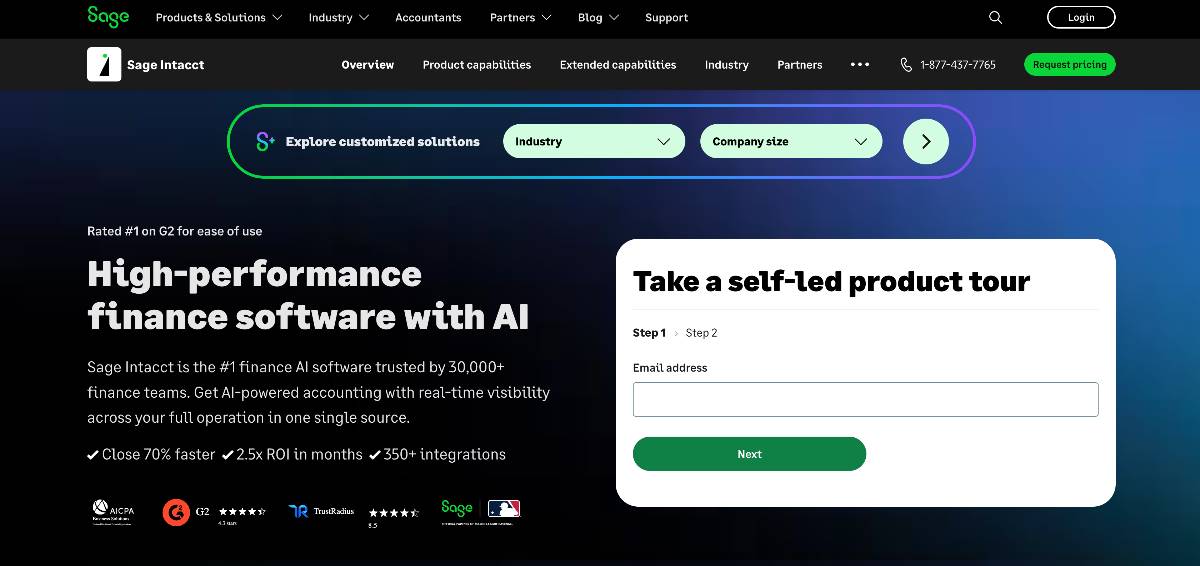
G2 rating: 4.3/5 (4,015)
Sage Intacct has AICPA endorsement and provides modular general ledger functionality. ⁶ The platform emphasizes dimensional reporting and industry-specific solutions for nonprofits and subscription-based businesses.
Core capabilities:
- Dimensional reporting analyzes data by department, project, location, or custom dimensions
- Industry-specific functionality for nonprofit fund accounting and subscription revenue
- Automated revenue recognition with contract billing workflows
- Multi-entity consolidation with drill-down to transaction detail
- Automations for recurring journal entries and expense allocations
Organizational fit: Nonprofit organizations, subscription businesses, and professional services firms requiring industry-specific accounting treatments.
Advantages:
- AICPA endorsement provides solid third-party validation
- Dimensional reporting eliminates complex chart- of- accounts structures
- Support infrastructure includes industry-specialized resources
- Modular pricing enables phased functionality implementation
Limitations:
- Total cost increases as modules are added to the base platform
- Configuration requires dedicated implementation time
- User interface reflects older design patterns
Pricing structure: Base pricing approximately $400 monthly, with increases based on modules, users, and transaction volume.
4. SoftLedger
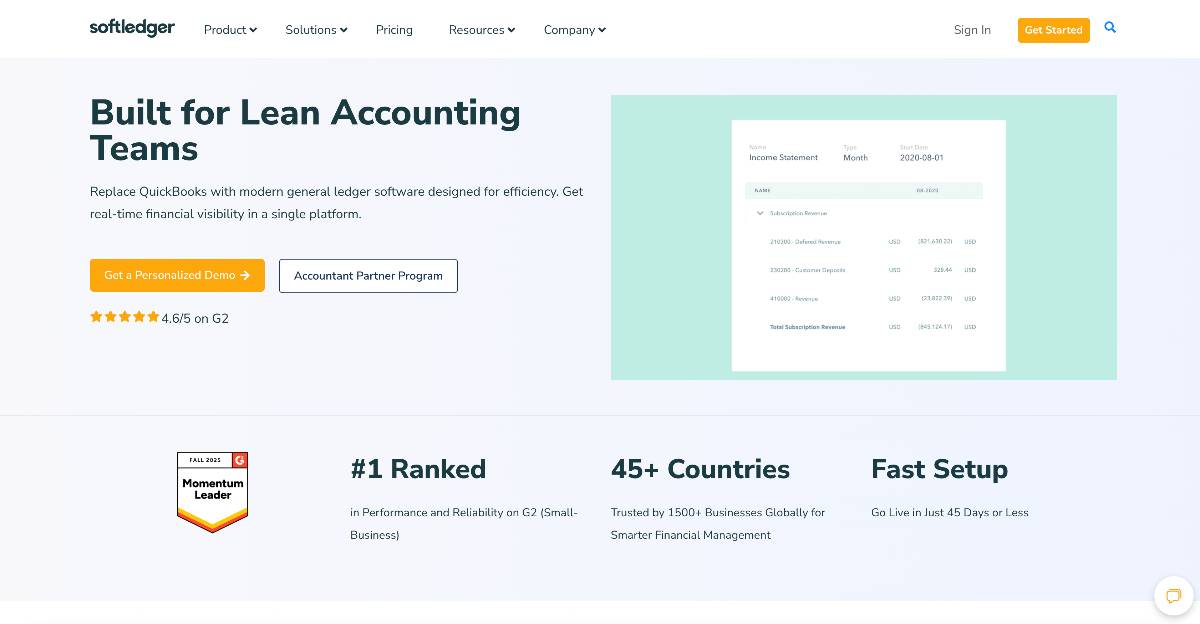
G2 rating: 4.6/5 (43)
SoftLedger offers general ledger functionality with native cryptocurrency accounting capabilities. The platform has API-first architecture, supporting custom integration development for technology companies.
Core capabilities:
- Native cryptocurrency asset accounting with wallet integration and valuation
- Customizable chart of accounts with workflow configuration
- Multi-currency transaction support and automated exchange- rate updates
- API-first architecture for custom integration development
- Optional modules for inventory management and order processing
Organizational fit: Technology companies, cryptocurrency businesses, and organizations needing extensive customization capabilities.
Advantages:
- Contemporary user interface
- Cryptocurrency accounting addresses emerging asset class requirements
- Flexible configuration accommodates diverse business models
- API availability supports custom integration development
Limitations:
- Smaller market presence, resulting in fewer third-party integration options
- Support response times may exceed larger vendor standards
- Pricing information requires vendor consultation
Pricing structure: Mid-market focus with costs starting at $750 monthly.
5. Xero

G2 rating: 4.4/5 (1,294)
Xero provides cloud-based general ledger functionality and unlimited user licensing. The platform emphasizes third-party application integration, with over 1,000 available connectors.
Core capabilities:
- Unlimited user access included for all subscription tiers
- Integration ecosystem includes 1,000+ third-party applications
- Bank reconciliation and invoicing functionality in base platform
- Multi-currency support available in higher-tier subscriptions
- Real-time collaboration enables simultaneous multi-user access
Organizational fit: Small businesses with 5-50 employees that need cost-effective multi-user accounting without per-user fees.
Advantages:
- Unlimited user licensing eliminates per-user cost escalation
- Extensive application marketplace provides specialized functionality
- International focus supports multi-currency requirements
- Collaborative features enable external accountant access
Limitations:
- Multi-entity functionality limited compared to mid-market platforms
- Advanced reporting requires third-party applications
- United States support infrastructure less developed than international markets
Pricing structure: Three subscription tiers: Early ($25 monthly), Growing ($55 monthly), and Established ($90 monthly). ¹¹
6. QuickBooks Online

G2 rating: 4.0/5 (3,569)
QuickBooks Online is the predominant small business accounting solution in United States markets. The platform provides integrated general ledger, accounts payable, accounts receivable functionality for service-based organizations.
Core capabilities:
- Automated bank-feed integration with transaction categorization
- Invoice generation with payment processing through QuickBooks Payments
- Basic inventory tracking for product-based businesses
- Payroll integration available through separate subscription
- Mobile application for receipt capture and transaction entry
Organizational fit: Service businesses with under 25 employee with straightforward accounting needs.
Advantages:
- Widely adopted and used by accountants
- Large third-party application ecosystem provides specialized functionality
- Lower entry-point pricing supports budget-conscious businesses
- Simplified interface reduces training requirements
Limitations:
- Per-user costs of $30 monthly compound for growing organizations
- Multi-entity functionality isn’t supported
- Organizations frequently outgrow platform capabilities and need to migrate to a more powerful system
- Advanced features require a premium subscription tier
Pricing structure: Simple Start ($38 monthly), Essentials ($75 monthly), Plus ($115 monthly), and Advanced ($275 monthly). Current pricing is subject to vendor changes. ¹⁰
7. Zoho Books

G2 rating: 4.4/5 (281)
Zoho Books provides cost-effective general ledger functionality with an emphasis on international small business requirements. The platform integrates with Zoho's broader business app ecosystem.
Core capabilities:
- Multi-currency support included across subscription tiers
- Project time tracking with billing functionality
- Automated workflow configuration and payment reminder scheduling
- Inventory management for product-based businesses
- Client portal enables customer self-service
Organizational fit: International small businesses, organizations already using the Zoho ecosystem, and budget-conscious startups.
Advantages:
- Competitive pricing supports organizations with limited budgets
- Multi-currency functionality is available at lower price points
- Integration with Zoho CRM and project management applications
- Suitable for international operations
Limitations:
- User interface is less intuitive compared to leading platforms
- Advanced functionality is limited relative to mid-market solutions
- Support quality varies by geographic location
- United States market penetration is lower than primary competitors
Pricing structure: Base subscription is approximately $15 monthly.
8. FreshBooks

G2 rating: 4.5/5 (945)
FreshBooks emphasizes invoice generation with payment processing and basic general ledger capabilities. The platform targets freelancers and microbusinesses that prioritize client billing over comprehensive accounting functionality.
Core capabilities:
- Client invoicing with customizable templates
- Online payment processing integration
- Time tracking for professional services
- Expense categorization with receipt capture
- Basic financial reporting and client communication tools
Organizational fit: Freelancers, consultants, and service providers with under 10 employees where invoicing is the primary requirement.
Advantages:
- Simplified interface reduces the learning curve
- Strong invoicing capabilities support service-based revenue models
- Affordable entry pricing for individual users
- Client-facing features improve payment collection
Limitations:
- Limited general ledger functionality compared to accounting-focused platforms
- Not suitable for organizations requiring detailed financial reporting
- Multi-entity and consolidation capabilities are not supported
- Scalability is limited as organizational complexity increases
Pricing structure: Lite ($10.50 monthly), Plus ($19 monthly), and Premium ($32.50 monthly).
9. CustomBooks
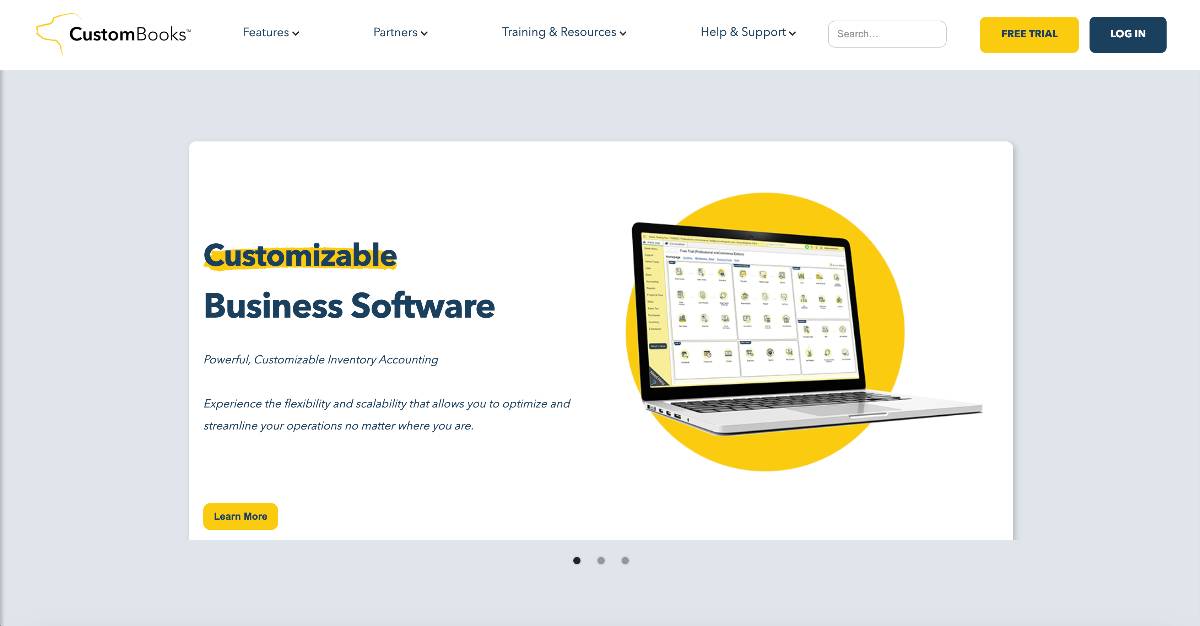
G2 rating: 4.4/5 (71)
CustomBooks provides industry-configured general ledger solutions for construction, nonprofit, manufacturing sectors. The platform delivers pre-configured functionality aligned with industry-specific compliance needs.
Core capabilities:
- Pre-configured chart of accounts and financial statement templates
- Job costing functionality for construction project accounting
- Fund accounting for nonprofit organizations
- Custom reporting, aligned with industry standards
- Specialized training and implementation support
Organizational fit: Niche industries with specific compliance requirements–including construction firms, nonprofits, and specialized manufacturing businesses.
Advantages:
- Industry-specific configuration reduces implementation time
- Compliance requirements are addressed through pre-built functionality
- Specialized support staff understand industry accounting practices
- Reporting templates are aligned with industry standards
Limitations:
- Limited flexibility for requirements outside industry templates
- Dedicated training investment required
- Smaller vendor creates potential stability concerns
- Market presence is limited compared to general-purpose platforms
Pricing structure: Pricing starts at $29 per month and, based on modules and configuration, can go up to $349.
10. Tabs3
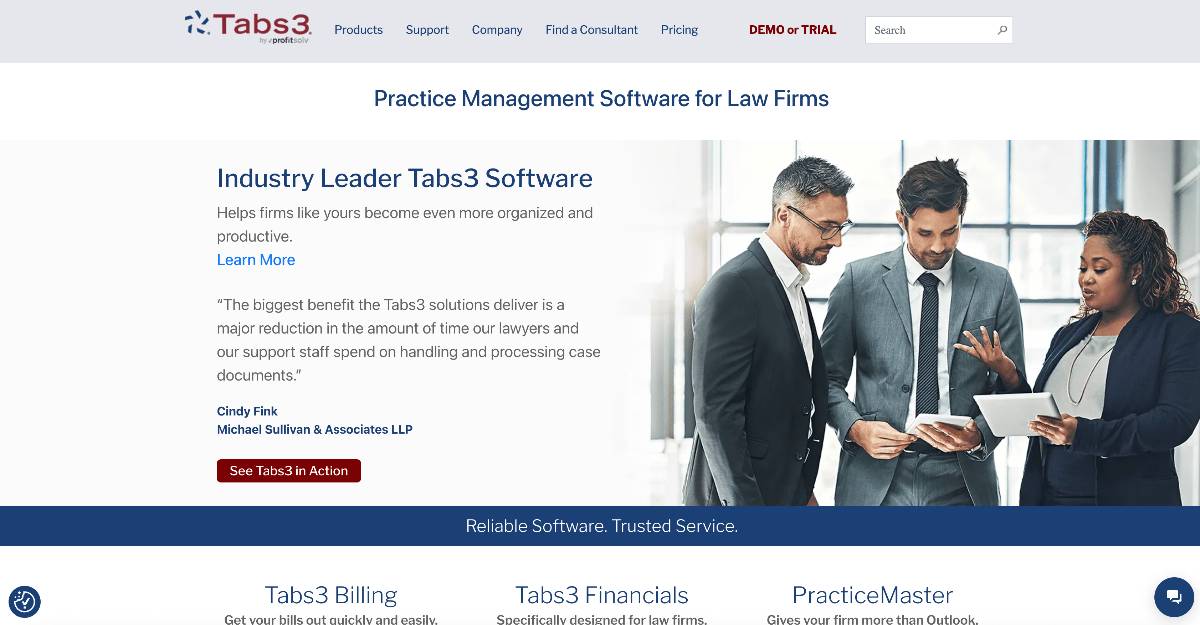
G2 rating: 4.4/5 (79)
Tabs3 specializes in legal-sector accounting, with an emphasis on trust accounting and client matter billing. The platform addresses law firm-specific compliance requirements, including IOLTA regulations.
Core capabilities:
- Trust accounting that complies with IOLTA regulatory requirements
- Time and billing by client matter
- Conflict checking functionality
- Client retainer management
- Bar association- compliant financial reporting
Organizational fit: Law firms requiring trust accounting–from solo practitioners to mid-sized firms.
Advantages:
- Purpose-built for law-firm accounting requirements
- Trust-accounting functionality addresses complex compliance needs
- Matter-based billing supports the legal industry’s revenue models
- Compliance features reduce regulatory risk
Limitations:
- Functionality is limited to legal applications
- User interface looks and feels dated
- Integration options are limited (outside the legal technology ecosystem)
- Not applicable for organizations outside the legal sector
Pricing structure: Custom pricing
Implementation considerations and practical applications
General ledger implementation requires assessment of automation capabilities, reporting requirements, and organizational scalability needs. The following analysis addresses practical considerations for companies evaluating general ledger solutions.
Automation impact on operational efficiency includes measurable improvements in transaction processing timelines. Businesses that have implemented automated general ledger systems report processing time reductions from 60-80% through automated bank feeds and recurring-entry functionality. ⁷ Manufacturing organizations that process 500 monthly transactions report a shift from 40 hours to approximately 8 hours on processing time after automating their workflows. Understanding how these transactions flow through the general ledger helps organizations identify automation opportunities.
Automated systems handle recurring transactions without manual involvement. Monthly rent expenses post automatically on scheduled dates. Depreciation calculations execute at period-end without manual journal entries. Bank reconciliation processes match imported transactions to ledger entries continuously rather than needing monthly general ledger reconciliation. The time savings allow accounting staff to focus on financial analysis, not data entry.
Real-time reporting improves an organization’s decision-making processes. Controllers can generate balance sheets at any point based on current transaction data. Cash-position visibility enables informed vendor payment timing decisions. Accounts-payable aging reports update continuously as invoices are entered and payments processed.
Organizations can use real-time dashboards to track KPIs in real time. Revenue trends, accounts-payable aging, and cash-runway calculations update automatically as transactions post. Plus, external auditors benefit from continuous audit-readiness rather than year-end documentation compilation.
Multi-entity consolidation cuts out manual spreadsheet work for companies with multiple legal entities. Private equity firms managing portfolio companies need consolidated financial statements for investor reporting while maintaining separate ledgers for each entity. Without proper multi-entity support, consolidation requires manual spreadsheet processes and extensive intercompany elimination calculations.
Proper multi-entity general ledger systems maintain separate books for each legal entity while providing consolidated views through unified dashboards. Intercompany transactions eliminate automatically during consolidation, and currency translation for international subsidiaries is handled according to defined exchange-rate protocols.
Migration timelines for mid-market organizations include data cleanup (requiring two weeks), system configuration (requiring three weeks), and testing (requiring one week). ⁹ The total implementation timeline usually ranges from six to eight weeks for companies that process 5,000 annual transactions. Modern general ledger platforms make the migration process easy, providing smooth import utilities for QuickBooks files, Excel spreadsheets, and CSV data formats.
Emerging technology trends in general ledger systems
General ledger technology continues to evolve with integration of artificial intelligence, compliance automation, and distributed ledger capabilities. Organizations considering AI native general ledger solutions should assess vendor roadmaps for emerging functionality.
AI integration includes predictive anomaly detection algorithms that learn organizational transaction patterns and identify unusual activities automatically. Modern systems flag potentially fraudulent transactions based on vendor- name variations, unusual payment amounts, and atypical transaction timing. Machine- learning models improve detection accuracy over time through feedback on flagged transactions. According to NetSuite's 2025 accounting trends report, early adopters of AI-powered GL features see improved financial control outcomes–like faster close processes and enhanced fraud detection.
Compliance automation handles revenue-recognition processing according to ASC 606 standards and lease accounting per ASC 842. The most powerful systems handle complex lease-term calculations and generate journal entries automatically. Regulatory updates happen automatically than needing internal technical resources or manual edits.
Blockchain applications create immutable transaction records for enhanced audit trail integrity. In the legal-industry, blockchain-backed general ledgers support client trust accounting. Their robust records satisfy regulatory requirements and simplify audits. This technology is currently still in the early-adoption phase.
Mobile-first platform development allows controllers to approve journal entries through apps on mobile devices. This gives more flexibility during remote work.
Best general ledger software FAQ
Software selection framework and decision criteria
General ledger software is about assessing a business’ requirements across multiple dimensions. Companies should evaluate platforms based on their current operational needs and projected growth over 3-5.
Selection factors include organizational size, industry-specific compliance needs, scalability, and integration compatibility with existing systems. Total cost of ownership includes implementation expenses and ongoing support fees.
Small businesses should prioritize ease of use and affordable entry pricing. Mid-market organizations need multi-entity support and advanced reporting capabilities. Enterprise operations need global consolidation functionality and customizable workflows that support regulatory compliance.
Industry-specific requirements also influence platform selection. Nonprofits require fund accounting capabilities; construction firms need job costing functionality; and legal practices must be able to handle trust accounting that complies with IOLTA regulations.
Companies should narrow their choice down to 2-3 finalist platforms, then request vendor demos with actual organizational data to see how the software would perform in reality.
.jpg)
.jpg)
.jpg)
%20(1).jpg)